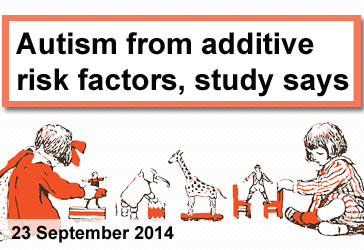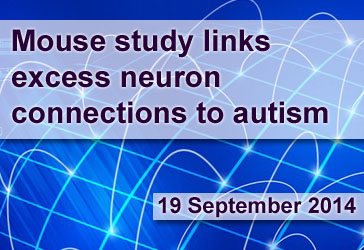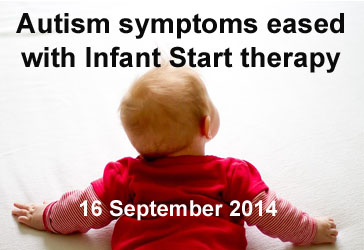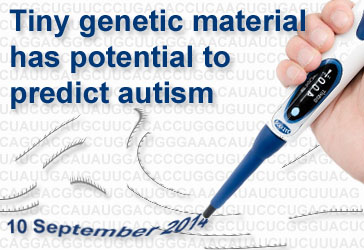Archives
September, 2014
Select a different month in the archive
ASD Diagnosis Increased with Additive Risk Factors
By Chelsea E. Toledo, M.A. on September 23, 2014

Background: Some researchers hypothesize that autism stems from a single causal event that initiates a cascade of cognitive and developmental delays. In contrast, others hypothesize that autism is the cumulative result of several co-existent risk factors. Studies have shown that disparities in social attention in children as young as 10 months old can predict whether those children later receive an ASD diagnosis, especially if they have an older sibling with ASD. Separate research has evaluated non-social attention—for example, how quickly a child can shift focus from one stimulus to another—and found differences in children as young as 6 months old, depending on their level of risk for developing ASD. By utilizing social and non-social attention tasks, researchers hope to learn about autism’s initial causes.
What’s new: The July 2014 issue of Developmental Science included a study assessing both social and non-social attention in children at 13 months of age. Using data from previous studies evaluating the two factors separately, the researchers combined data collected from a total of 145 children who had either undergone a task to follow the gaze of a person shown on a screen or the task to shift focus from one stimulus shown on a screen to another. They found that disparities in social and non-social attention had cumulative effects in predicting an ASD diagnosis—that is, infants who followed the gaze of the person on the screen for short periods of time and who also took long periods of time to shift from one task to another had a higher chance of developing ASD than those who scored better on each task.
Why it’s important: This is the first study to formally test the relationship between multiple factors (i.e. social and non-social attention) as they relate to the development of ASD. This research paves the way for future studies to more conclusively determine whether ASD develops due to cumulative risk, as this study suggests, or from a single causal factor.
Help me understand :
| Source(s) : |
| Tweet |
Too Many Neurons Partnered Up in Autism
By Ishita Das, PhD on September 19, 2014

Background: Soon after birth, the brain eliminates a large number of neural connections—a process called pruning. Researchers believe this fine-tuning affects connections that are weaker or in excess. Pruning proceeds alongside the earliest phases of learning. It likely helps the brain develop the sophisticated circuitry needed to respond to the environment. Researchers are investigating if pruning abnormalities underlie Autism Spectrum Disorder (ASD).
What’s new: A new study suggests that children and adolescents with ASD fail to eliminate excess neural connections after birth. New York researchers report that neurons in the brain’s temporal lobe contain more tree-like protrusions, known as spines, in adolescents with ASD compared to controls. This difference is discernable in brain samples from children with ASD as well. These spines receive input from other neurons. The temporal lobe is associated with language and speech perception, auditory and visual processing, and has been implicated in ASD etiology.
Using a mouse model, the group found that knocking out a pathway responsible for degrading parts of the cell reduced spine pruning and led to a significant increase in spine density in adolescent mice. Furthermore, using additional mouse models, the team connected spine density changes to deficiencies in social behavior and social interaction in the mice. Treatment with a drug, rapamycin, alleviated many of the social deficiencies seen in an ASD mouse model.
Why it’s important: This is the first study to show that a specific biological pathway is important for spine pruning, which this study implicates in ASD. Connecting these physical changes in the brain with behavioral features in mice is a major accomplishment in behavioral neuroscience.
Help me understand :
| Source(s) : |
| Tweet |
Very Early Therapy Eases ASD Symptoms, Study Suggests
By Shana R. Spindler, PhD on September 16, 2014

Background: While many children with autism are diagnosed during their late toddler and preschool years, there is an ongoing attempt to identify very early signals, such as lack of eye contact, even during infancy. Newer studies are now focusing on treatment for infants suspected of having autism or being at increased risk for the disorder.
What's new: Researchers at the University of California, Davis, MIND Institute report a promising behavioral therapy for Autism Spectrum Disorder (ASD), called Infant Start. Based on the Early Start Denver Model, Infant Start is a parent-led behavioral intervention that emphasizes parent-child social interactions from infancy.
Symptomatic infants between seven and 15 months of age, and their parents, participated in a 12-week, low-intensity pilot program. During weekly sessions, highly trained therapists coached parents in individualized behavioral therapies, which parents continued in the home environment. By 18 months, the children who participated in Infant Start had significantly fewer autism symptoms than the children of families who chose not to enroll in the pilot study.
Why it's important: This study supports the idea that early treatment for autism may alleviate some of the core symptoms associated with the disorder, as seen in previous studies on toddler-age children.
Help me understand :
| Source(s) : |
| Tweet |
Possible Autism Biomarker in Tiny Regulators
By Shana R. Spindler, PhD on September 10, 2014

Background: Several studies have shown that early intervention helps children with Autism Spectrum Disorder (ASD) improve critical social and language skills. Unfortunately, doctors still lack a non-behavioral clinical test to find out if a child has or will develop ASD. Diagnosis is therefore delayed until the child reveals social or language deficits, usually by two to four years of age. Researchers are now searching for autism biomarkers, an objective measurement that can predict the likelihood that a child has autism, even before behavioral symptoms used for diagnosis appear.
What’s new: A group of Japanese researchers report in Molecular Autism that a new class of small gene regulators, called microRNAs (miRNAs), may help predict ASD. The team of scientists found that individuals with autism had higher levels of eight specific miRNAs in serum samples compared to control individuals. In contrast, five miRNAs showed lower levels in those with autism. MicroRNAs are like little zip ties that bind gene products to control the cell from making certain proteins. The researchers identified several proteins involved in neuron biology among the protein targets affected by the miRNAs in this study.
Why it’s important: To date, the medical community lacks a biomarker of any type for autism. This is the first study to show that specific miRNAs are found at different levels in the serum of those with autism versus controls. Serum collection is a relatively safe and noninvasive procedure. These results suggest that the measurement of serum miRNAs may serve as a biomarker for autism, but additional studies are needed to confirm this finding.
Help me understand :
| Source(s) : |
| Tweet |

